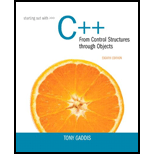
Concept explainers
Pointer:
Pointer, the name itself references the purpose of the pointer. Pointers point to a location in memory.
- Pointer is a special type of variable to store the address of the memory location, which can be accessed later.
- If an asterisk “*” operator is present before the variable, then that variable is referred as pointer variable.
- It is also called as dereferencing or indirection operator.
- Pointer is just a type of variable that stores the addresses of other variables.
- Using pointers, we can access the address of a variable; the data stored in that variable can be retrieved.
Syntax of pointer variable declaration:
<variable-type> *<variable-name>;
Example for pointer variable declaration:
//definition of pointer variable
int *ptrvar;
Where,
- int is the variable type.
- * ptrvar is the pointer variable name.
Pointer will allow the user to indirectly access and manipulate the data contents of the variable. A pointer variable will hold the address of the data contents.
Note:
- When the symbol “&” is placed prior the pointer variable, it will hold address of the pointer variable.
- When the symbol “*” is placed prior the pointer variable, it will hold the value of the pointer variable.
Purpose of “new” operator:
The main purpose of the “new” operator is to dynamically allocate memory. Dynamic memory allocation is process where an individual chunk of memory space is allocated by the compiler that is sufficient for the storage of variables. This kind of allocation is possible with pointer variables.
Example:
Consider a pointer variable of type integer needs to be allocated dynamically and it can be made possible using new operator as shown below:
//null pointer declaration
int *myptr = nullptr;
//dynamic allocation of memory
myptr = new int;
Want to see the full answer?
Check out a sample textbook solution
Chapter 9 Solutions
Starting Out with C++ from Control Structures to Objects (8th Edition)
- Draw an ERD that represents a book in a library system. Be sure to add relationship types, key attributes, attributes and multiplicity on the ERD.arrow_forward2:21 m Ο 21% AlmaNet WE ARE HIRING Experienced Freshers Salesforce Platform Developer APPLY NOW SEND YOUR CV: Email: hr.almanet@gmail.com Contact: +91 6264643660 Visit: www.almanet.in Locations: India, USA, UK, Vietnam (Remote & Hybrid Options Available)arrow_forwardProvide a detailed explanation of the architecture on the diagramarrow_forward
- hello please explain the architecture in the diagram below. thanks youarrow_forwardComplete the JavaScript function addPixels () to calculate the sum of pixelAmount and the given element's cssProperty value, and return the new "px" value. Ex: If helloElem's width is 150px, then calling addPixels (hello Elem, "width", 50) should return 150px + 50px = "200px". SHOW EXPECTED HTML JavaScript 1 function addPixels (element, cssProperty, pixelAmount) { 2 3 /* Your solution goes here *1 4 } 5 6 const helloElem = document.querySelector("# helloMessage"); 7 const newVal = addPixels (helloElem, "width", 50); 8 helloElem.style.setProperty("width", newVal); [arrow_forwardSolve in MATLABarrow_forward
- Hello please look at the attached picture. I need an detailed explanation of the architecturearrow_forwardInformation Security Risk and Vulnerability Assessment 1- Which TCP/IP protocol is used to convert the IP address to the Mac address? Explain 2-What popular switch feature allows you to create communication boundaries between systems connected to the switch3- what types of vulnerability directly related to the programmer of the software?4- Who ensures the entity implements appropriate security controls to protect an asset? Please do not use AI and add refrencearrow_forwardFind the voltage V0 across the 4K resistor using the mesh method or nodal analysis. Note: I have already simulated it and the value it should give is -1.714Varrow_forward
 EBK JAVA PROGRAMMINGComputer ScienceISBN:9781337671385Author:FARRELLPublisher:CENGAGE LEARNING - CONSIGNMENT
EBK JAVA PROGRAMMINGComputer ScienceISBN:9781337671385Author:FARRELLPublisher:CENGAGE LEARNING - CONSIGNMENT C++ Programming: From Problem Analysis to Program...Computer ScienceISBN:9781337102087Author:D. S. MalikPublisher:Cengage Learning
C++ Programming: From Problem Analysis to Program...Computer ScienceISBN:9781337102087Author:D. S. MalikPublisher:Cengage Learning New Perspectives on HTML5, CSS3, and JavaScriptComputer ScienceISBN:9781305503922Author:Patrick M. CareyPublisher:Cengage Learning
New Perspectives on HTML5, CSS3, and JavaScriptComputer ScienceISBN:9781305503922Author:Patrick M. CareyPublisher:Cengage Learning C++ for Engineers and ScientistsComputer ScienceISBN:9781133187844Author:Bronson, Gary J.Publisher:Course Technology Ptr
C++ for Engineers and ScientistsComputer ScienceISBN:9781133187844Author:Bronson, Gary J.Publisher:Course Technology Ptr Systems ArchitectureComputer ScienceISBN:9781305080195Author:Stephen D. BurdPublisher:Cengage Learning
Systems ArchitectureComputer ScienceISBN:9781305080195Author:Stephen D. BurdPublisher:Cengage Learning Programming with Microsoft Visual Basic 2017Computer ScienceISBN:9781337102124Author:Diane ZakPublisher:Cengage Learning
Programming with Microsoft Visual Basic 2017Computer ScienceISBN:9781337102124Author:Diane ZakPublisher:Cengage Learning





